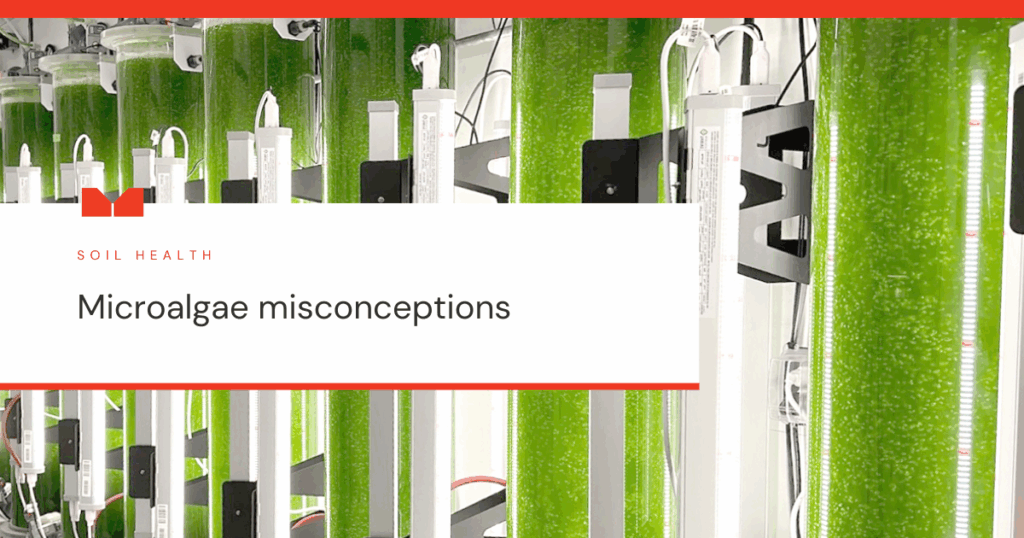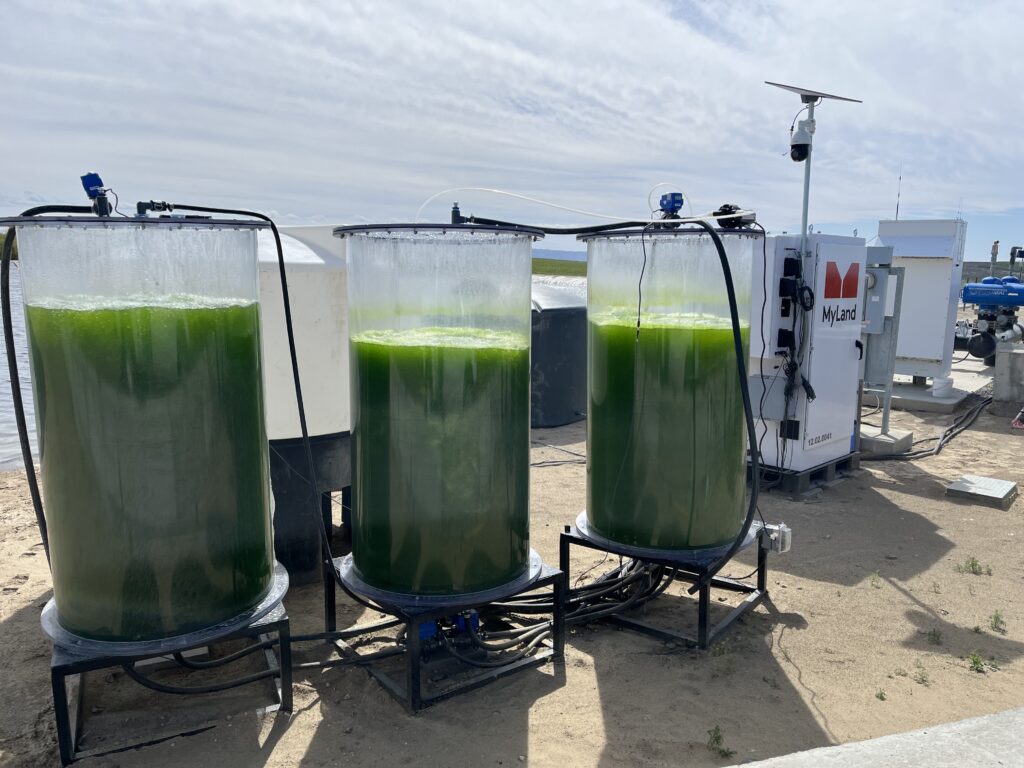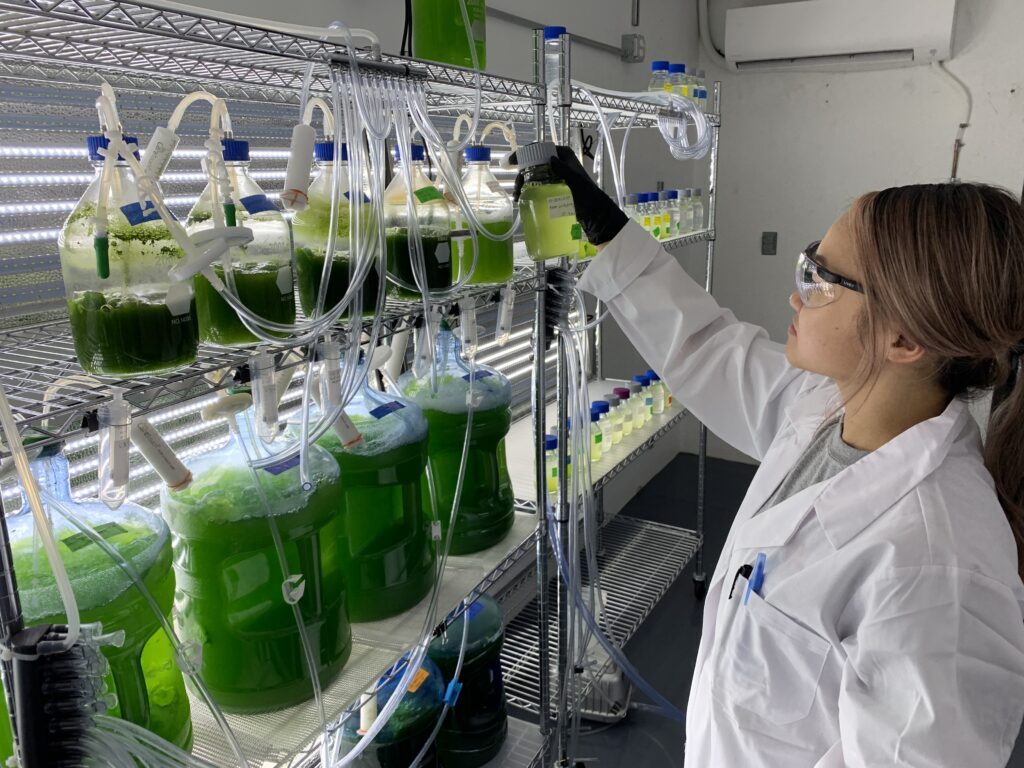
Debunking 9 Myths About Microalgae’s Role in Soil Health
At MyLand, we hear a lot of questions about microalgae, and many are rooted in misconceptions. Some picture unwanted green growth in lakes or ponds, but in reality, microalgae are one of the most effective tools we have for restoring soil health and improving crop performance.
Microalgae are naturally present in soils all over the world. When we increase their abundance, they work as powerful allies in improving soil structure, supporting nutrient cycling, and building resilience against stress. We’ve seen these benefits lead to higher yields, better quality crops, and more profitable farms for our growers.
In this post, we’ll break down nine common myths about algae in agriculture.
Microalgae are powerful soil health champions
Myth #1: Algae are harmful or invasive
Truth: While harmful algal blooms in lakes and oceans often give algae a bad reputation, the story is very different in the soil. Many soil-native microalgae provide significant soil health benefits, contributing to a more sustainable and productive agricultural system.
“MyLand exclusively uses green algae, and through extensive research, I have found no toxins produced by green algae,” said Andrew Ayers, MyLand’s Director of Algae Impact. “The right algae can be safely integrated into farming practices with beneficial effects on soil and crops.”
Let’s take a quick look at the benefits of microalgae for soil health:
- Enhanced microbial activity
- Improved nutrient cycling
- Higher organic matter
- Healthier soil aggregation
- Improved aeration
- Better water retention & water holding capacity
- Boosted plant nutrient uptake
- Improved crop productivity
Algae are found in many different environments
Myth #2: Algae only grow in water
Truth: Algae grow in a number of environments, and are naturally occurring in the soil, where they play an important role in balanced soil biology. The role of algae in soil fertility is well-documented (in places like The Journal of Phycology), as certain strains have adapted to terrestrial conditions and can enhance soil productivity by interacting with microbes and plant roots. Soil-dwelling microalgae form an essential part of the underground ecosystem, leading to a healthier soil microbiome that’s more capable of supporting healthier crops.
Microalgae are a powerful catalyst to healthy soil
Myth #3: Algae doesn’t benefit crops
Truth: At MyLand, we’re passionate about algae’s powerful role as a catalyst to healthy and productive soil. Through the MyLand Service, we infuse live, native microalgae into our growers’ soil, and the results have been tremendous.
Several growers reported increases of more than 30% in yields, revenue, and soil organic matter. How is this possible?
According to Andrew, when microalgae are introduced to farm soil that’s been dependent on artificial inputs, plants jump into action, releasing sugars and nutrients from their roots to feed the microalgae, which in turn support beneficial bacteria and fungi. This symbiotic relationship strengthens the soil microbiome and impacts the full spectrum of physical, chemical, and biological soil properties. And over time, algae has been shown to reduce a farm’s dependence on inputs.
This process creates a crucial communication link in the soil, allowing a symbiotic relationship where plants actively nourish their microbial community and thrive.
Live, native microalgae are uniquely beneficial
Myth #4: Microalgae are just fertilizers
Truth: It’s true that adding a dose of any microalgae would add nutrients to the soil. Even bottled algae can give some benefit, but they cannot match the benefits of living or local algae.
Live, native microalgae play a key role. Live algae have a whole host of soil functions that complete the biological cycle, while native microalgae are best suited to thrive in that farm’s unique soil.
Their primary benefits cover a broad spectrum of soil functions, acting to improve soil structure, increase microbial diversity, and enhance soil’s natural processes—rather than acting as a simple nutrient source. This is because living algae will naturally reproduce in the soil, increasing the number of microalgae present in the soil and multiplying the benefits.
Microalgae are a foundational element of farm management
Myth #5: Microalgae can replace all other soil amendments
Truth: Microalgae lend immense support to improving soil health, but they don’t eliminate the need for good soil management. They work best as part of an integrated soil health approach, in conjunction with existing practices to support optimal soil microbiology over time.
Microalgae integrate seamlessly into existing farm irrigation
Myth #6: Algae will clog my farm’s irrigation system
Truth: The MyLand Service only uses unicellular algae, which is single-celled and able to pass through any irrigation system. In fact, MyLand won the 2025 AgTech Breakthrough Award for Overall Smart Irrigation Solution, recognizing how MyLand transforms traditional irrigation into a powerful tool for soil health restoration and farm resilience.
“With MyLand, irrigation is made smarter by turning it into a delivery system for living biology and long-term resilience, amplifying a farm’s live, native microalgae to create healthier soil,” said Bryan Vaughn, Managing Director, AgTech Breakthrough.
So, rest assured: the microscopic microalgae will pass easily through irrigation systems to reach the soil and begin their journey as part of the soil microbiome.

MyLand System out in the field.
Algae support cleaner waterways and reduce runoff
Myth #7: Algae contribute to pollution
Truth: Beneficial soil-based algae help to reduce nutrient runoff by strengthening nutrient cycling and preventing excess fertilizer from leaching into waterways. In fact, they actively mitigate pollution by absorbing harmful toxins and capturing carbon dioxide. Healthier soils, powered by algae, mean not just stronger plants but also cleaner water for our communities.
Microalgae easily integrate into the soil
Myth #8: Adding microalgae to soil will cause slime or biofilms
Truth: The right types of microalgae for soil do not create slimy coatings or harmful biofilms; instead, they integrate directly into the soil ecosystem and play a key role in supporting microbial balance.
Microalgae improve soil health
Myth #9: Microalgae is snake oil
Truth: Microalgae have been proven to have a direct impact on soil health. It can be difficult for growers to make the best decisions for their farms since there are so many options for how to best manage your operation.
That’s why MyLand has collected data from Contract Research Organizations (CROs), third-party analysts that have assessed our growers’ soil with and without MyLand, and have shown a positive impact on yield, crop consistency, and more. You can read the study here.

Inside the MyLand algae lab.
Microalgae are a cornerstone of soil health
The role of microalgae in soil fertility has been shown to improve farm profitability, crop quality and consistency, and overall soil resilience. Microalgae work in harmony with crops, strengthening their ability to withstand environmental stressors and produce higher yields. By integrating microalgae into farming practices, growers can take advantage of a powerful natural tool for soil enrichment.
See how microalgae can transform your soil
At MyLand, we know no two farms are alike. That’s why we work closely with each grower to understand their land and customize our Service to their needs. If you’re ready to see how microalgae can transform your soil and strengthen your crops, get in touch today.